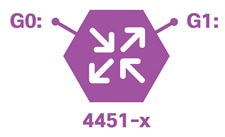Cisco SAFE Overview Guide
Available Languages
Bias-Free Language
The documentation set for this product strives to use bias-free language. For the purposes of this documentation set, bias-free is defined as language that does not imply discrimination based on age, disability, gender, racial identity, ethnic identity, sexual orientation, socioeconomic status, and intersectionality. Exceptions may be present in the documentation due to language that is hardcoded in the user interfaces of the product software, language used based on RFP documentation, or language that is used by a referenced third-party product. Learn more about how Cisco is using Inclusive Language.
Complexity is one of the main challenges facing security professionals. Technology constantly fragments into new uses, and organizations utilize dozens of products that do not interoperate seamlessly. This multiplies attack surfaces, which in turn complicates defenses. Fraudsters exploit this weakness to develop advanced threats for more lucrative schemes.
The industry desperately needs a resource that simplifies the problem. The solution must be comprehensive, credible, and about more than just products; it needs to focus on the threats to your business.
Cisco Secure Architecture for Everyone (SAFE) is a security model and method used to secure business. It focuses on threats—and best practices for defending against them. Cisco SAFE illustrates today’s business challenges in a language that changes the way we think about security. It uses simple concepts to focus on the complexities of today, so that we’re prepared for the challenges of tomorrow.
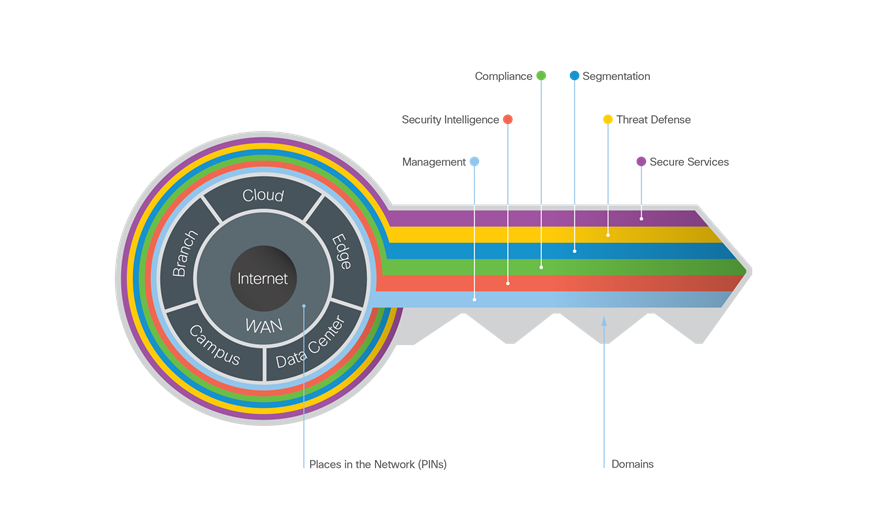
SAFE provides the Key to simplify cybersecurity into Secure Places in the Network (PINs) for infrastructure and Secure Domains for operational guidance.
The Cisco SAFE Security Reference Model
Using a security reference model, the challenges of securing today’s business functions are simplified into a building block approach. The model incorporates today’s security best practices, architectural discussions, and laboratory-tested designs from the brightest security minds across Cisco, its customers, and partners. SAFE’s Cisco Validated Designs address critical security topics. They have been deployed, tested, and they document “how to do it.”
SAFE includes:
● Business use cases illustrating the surface that fraudsters can attack
● Security capabilities mapped to common threats within business use cases
● Reference architectures that logically arrange the security capabilities into blueprints
● Designs using the reference architectures for common deployment scenarios and solutions. Delivered as Cisco Validated Designs (CVDs).
The SAFE method customizes the model for individual companies. Using the SAFE toolkit and collateral, companies can analyze the threats and risks to their own business. Contact your Cisco account team to use the method in a guided SAFE workshop. The workshop can be refreshingly helpful because it brings departments of the company together that might not normally interact. Executives come together with stakeholders from business and compliance as well as security and Infrastructure technologists to map out concerns related to how security affects the business. The workshop results in a tailored security architecture for your business.
SAFE is not a single answer.
The model is a reference for common threats, risks, and policies across the business of a company. This does not mean that all companies are the same. Obviously, the concerns of retailers are not the same
as the needs of healthcare organizations. However, when viewing the challenges of security in its entirety, patterns begin to emerge. Regardless of the industry, certain business methods are likely to be employed and, consequently, exploited. Foundational capabilities and functional controls are necessary to defend the attack surface. For example, access to the network, utilization of business applications, and communications using email are common across all companies. Connections to the Internet for web browsing and to access services coming from the cloud present additional business security concerns. SAFE provides guidance to common business functions that require security capabilities, culminating in a reference for end-to-end security.
The SAFE method customizes the best practices of the reference model to individual companies. It ensures that business goals are measurably secured according to each company’s security policy and risk appetite, using the following steps:
● Identify business goals
● Break down the network into manageable pieces
● Establish a criteria for the success of the business
● Categorize risks, threats, and policies
● Build the security solution
| Phase |
Example Icon |
Description |
Function |
| Key |
|
Organizational Model |
The Key to SAFE provides the Key to simplify cybersecurity into Secure Places in the Network (PINs) for infrastructure and Secure Domains for operational guidance. |
| Business Flow |
|
Use Cases |
Business flows use colored lines to depict use cases and show where data flows through a network. |
| Threat |
|
Unauthorized Packets. This threat is blocked by firewalls. |
The top security threats of an organization are catalogued. |
| Capability |
|
Firewall |
Capabilities are used to describe security functions. |
| Architecture |
|
Logical Router. This logical router has firewall capability. |
Architectures are used to logically arrange the security capabilities. |
| Design |
|
4451x with Firewall |
Designs are used to provide specific products and services. |
Table 1. The SAFE Model Icons
Business flows, or use cases, are defined in this phase. Using them as a basis, security capabilities are applied to address threats, risks, and policy.
Small Branch Capabilities and Business Flows
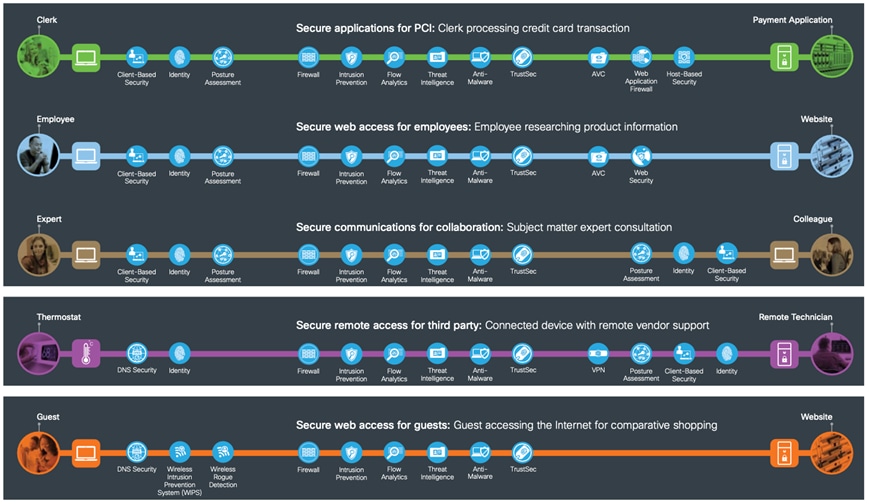
A logical security architecture is defined using the security capabilities that were identified in the business flows.
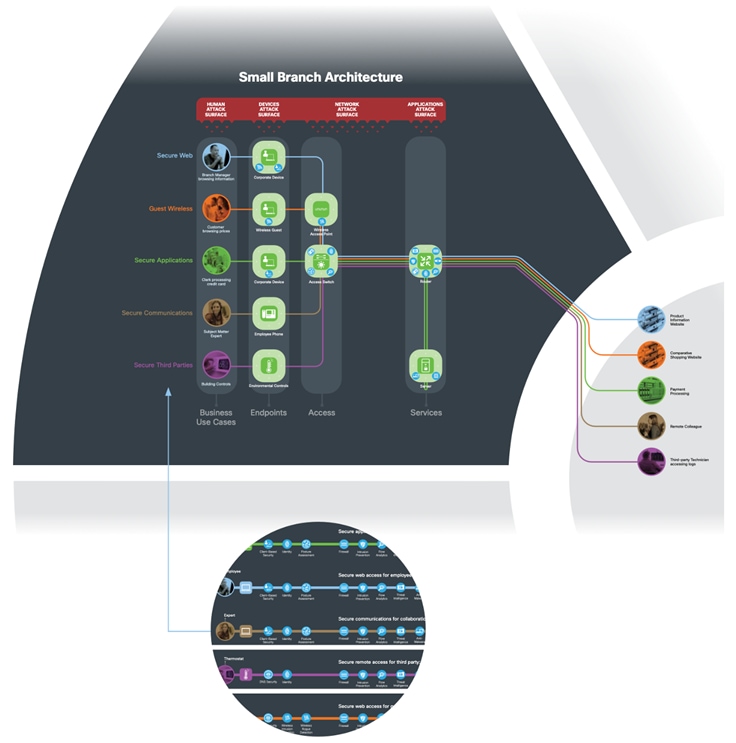
Using the security architecture, a specific design is created to implement the required security capabilities, complete with a product list, configuration, services, and cost.
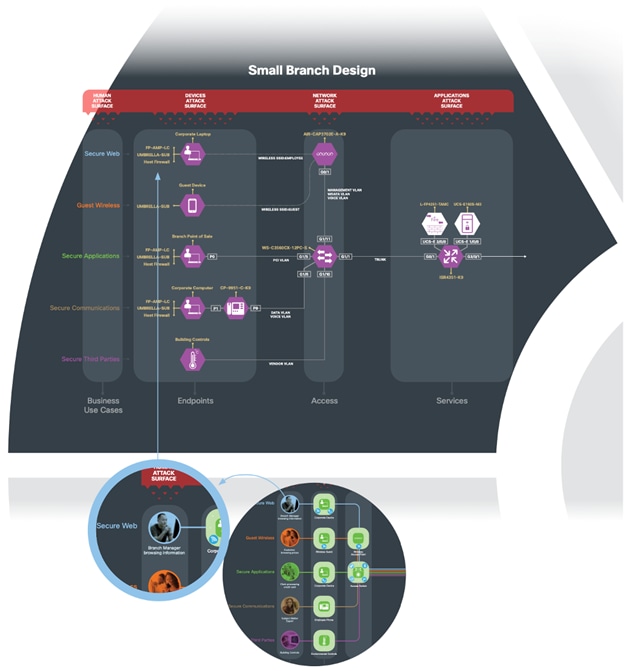
SAFE’s toolkit and collateral simplify the discussion
SAFE bridges the gap between business and technical audiences by providing a communal security-centric language for business concerns and technical solutions. Using innovative icons, each business line can visualize the security required, including accounting for the gaps.
SAFE tools include:
● Capability icons to represent business flows and the appropriate security controls
● Architecture guides to reference appropriate layers of security and their justifications
● Design guides that provide solutions with step-by-step instructions on how to configure the infrastructure based on Cisco’s validated laboratory testing
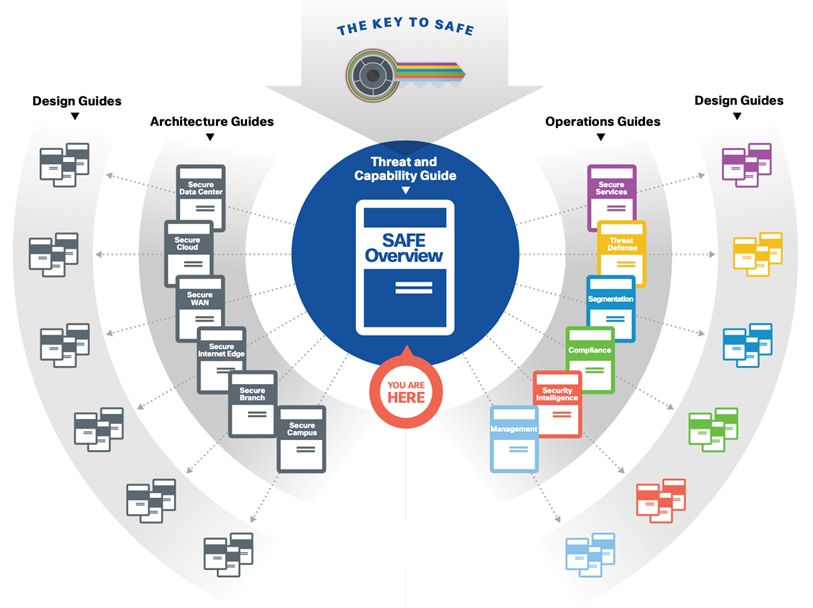
The attack surface of a company is anyone or anything that can be targeted. Any human, using any device, on any network, accessing any application can be attacked.
| Attack Surface |
Description |
| HUMAN |
Know who is on your network |
| DEVICE |
Know that devices are not infected |
| NETWORK |
Networks can be compromised |
| APPLICATIONS |
Services can be exploited |
Table 2. Attack Surface
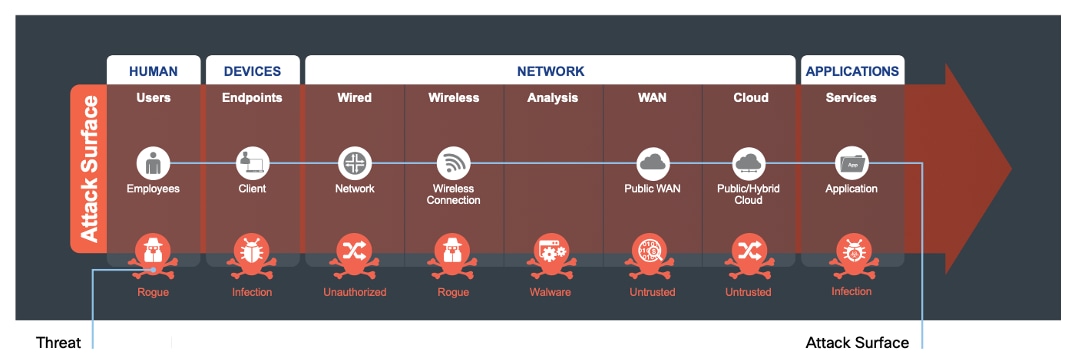
The attack surface needs to be secured by appropriate capabilities. Each target may be part of a larger overall attack. By identifying a company’s business flows which represent the companys attack surface, proper security capabilities can be applied.
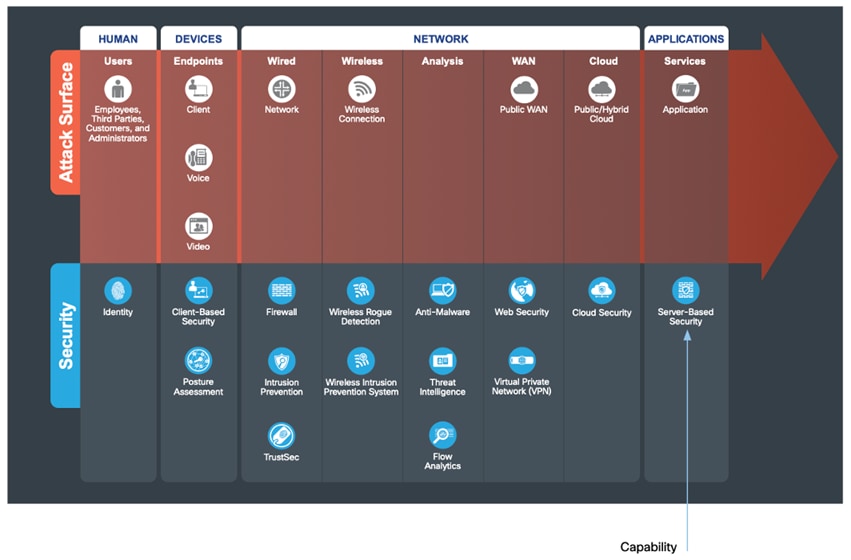
Three categories of users have a role on your network:
Internal: Internal flows are activities that employees perform on the company network.
Third Party: Third-party flows are guests, vendors, service providers, or partners who access the company network.
Customers: Customer flows can be a variety of services, such as website portals and customer information.
Policy, risks, and threats affect each of them, requiring security capabilities for protection.
SAFE’s color-coded business flows illustrate the security needed for each role. These flows depict the attack surface, ensuring that controls are easily accounted for. For example, when an employee goes online to do research, or a customer makes a purchase on your e-commerce site, these activities provide fraudsters something to attack.
By documenting and planning the security of all business flows within your company, maintaining security is simplified.
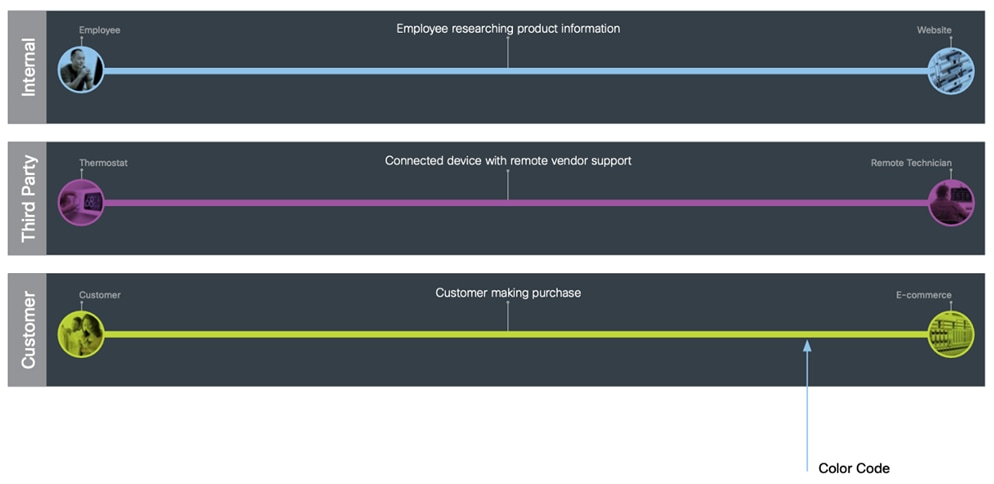
Functional controls are common security considerations that are derived from the technical aspects of the business flows.
| Functional Control |
Definition |
| Secure Applications |
Applications require sufficient security controls for protection. |
| Secure East/West Traffic |
Data that securely moves between internal and external resources. |
| Secure Access |
Employeea, third parties, customers, and devices securely accessing the network. |
| Secure Remote Access |
Secure remote access for employees and third-party partners that are external to the company network. |
| Secure Communications |
Email, voice, and video communications connect to potential threats outside of company control and must be secured. |
| Secure Web Access |
Web access controls enforce usage policy and prevent network infection. |
Table 3. Functional Controls
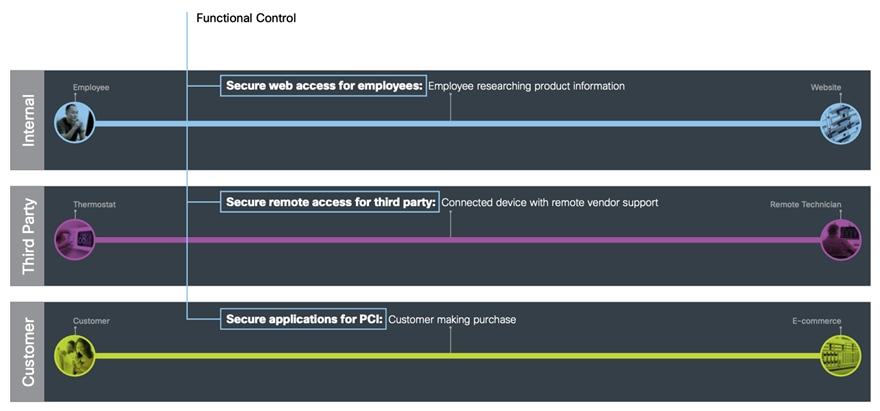
SAFE’s capability icons simplify the security discussion by putting the focus on the function necessary to perform a specific feature before identifying a product.
For example, Cisco sells Adaptive Security Appliances, Firepower appliances, Meraki routers with firewalls, Cat6k with firewalls, and Cisco ISR with firewalls. For simplicity, any of these are identified by their capability (firewall). Subsequent SAFE steps will specify model and feature requirements.
Security capabilities are used to mitigate threats on the attack surface of a business flow. The appropriate capability icons are applied along the business flow based on the policy, risk, and threats of its attack surface.
For example, the “Employee researching product information” business flow is analyzed from source to destination.

Based on where they are applied on the business flows, security capabilities can be grouped into three types: Foundational, Access, and Business.
Foundational Capabilities work together to protect applications and traffic. They use segmentation, visibility, and analysis in a comprehensive architectural approach. All business flows require foundational security capabilities.

| Security Capability Icon |
Security Capability Description |
Threat Icon |
Threat Description |
|
|
Firewall: Stateful filtering and protocol inspection between layers and the outside Internet and service provider connections. |
|
Unauthorized access and malformed packets between and within the data center. |
|
|
Intrusion Prevention: Blocking of attacks by signatures and anomaly analysis. |
|
Attacks using worms, viruses, or other techniques. |
|
|
Flow Analytics: Network traffic metadata identifying security incidents. |
|
Traffic, telemetry, and data exfiltration from successful attacks. |
|
|
Threat Intelligence: Contextual knowledge of existing and emerging hazards. |
|
Zero-day malware and attacks. |
|
|
Anti-Malware: Identify, block, and analyze malicious files and transmissions. |
|
Malware distribution across networks or between servers and devices. |
|
|
TrustSec: Policy-based segmentation |
|
Unauthorized access and malicious traffic between segments. |
Table 4. Foundational Capabilities
Access capabilities secure users, devices, servers, and applications as they access or provide network services.


Users: Employees, contractors, customers, and administrators.
| Security Capability Icon |
Security Capability Description |
Threat Icon |
Threat Icon Description |
|
|
Identity: Identity-based access. |
|
Attackers accessing restricted information resources. |
Table 5. User Access Capabilities

Devices such as PCs, laptops, smartphones, tablets.
| Security Capability Icon |
Security Capability Description |
Threat Icon |
Threat Description |
|
|
Client-based Security: Security software for devices with the following capabilities: |
- |
- |
|
|
Anti-Malware |
|
Malware compromising systems. |
|
|
Anti-Virus |
|
Viruses compromising systems. |
|
|
Cloud Security |
|
Redirection of user to malicious website. |
|
|
Personal Firewall |
|
Unauthorized access and malformed packets connecting to client. |
|
|
Posture Assessment: Client endpoint compliance verification and authorization. |
|
Compromised devices connecting to infrastructure. |
Table 6. Device Access Capabilties

| Security Capability Icon |
Security Capability Description |
Threat Icon |
Threat Description |
|
|
Server-based Security: Security software for servers with the following capabilities: |
- |
- |
|
|
Anti-Malware: Identify, block, and analyze malicious files and transmissions. |
|
Malware distribution across servers. |
|
|
Anti-Virus: |
|
Viruses compromising systems. |
|
|
Cloud Security: Security services from the cloud |
|
Redirection of session to malicious website. |
|
|
Host-based Firewall: Provides micro-segmentation and policy enforcement. |
|
Unauthorized access and malformed packets connecting to server. |
|
|
Posture Assessment: Server compliance verification, authorization, and patching. |
|
Targeted attacks taking advantage of known vulnerabilities. |
|
|
Disk Encryption: Encryption of data at rest. |
|
Theft of unencrypted data. |
|
|
Flow Analytics: Network traffic metadata identifying security incidents. |
|
Traffic, telemetry, and data exfiltration from successful attacks. |
|
|
Application Dependency Mapping: |
|
Exploiting a misconfigured firewall policy. |
|
|
Vulnerability Assessment and Software Inventory: |
|
Exploiting unpatched or outdated applications. |
|
|
Process Anomaly Detection & Forensics: |
|
Exploiting privileged access to run shell code. |
|
|
Tagging: Grouping for Software Defined Policy |
|
Unauthorized access and malicious traffic between segments. |
|
|
Policy Generation, Audit, and Change Management: |
|
Targeted attacks taking advantage of known vulnerabilities. |
Table 7. Server and Application Access Capabilites
Business capabilities are used to secure risks introduced by business practices that are not handled by the foundational and access groups. Email, web access, and remote access directly connect to potential malicious entities (like the web, phishing, and compromised partners) which are outside the control of a company and require additional security capabilities.

| Security Capability Icon |
Security Capability Description |
Threat Icon |
Threat Description |
|
|
Web Security: Web, DNS, and IP-layer security and control for the campus. |
|
Attacks from malware, viruses, and redirection to malicious URLs. |
|
|
Email Security: Messaging integrity and protections. |
|
Infiltration and exfiltration via email. |
|
|
Application Visibility and Control (AVC): Deep packet inspection (DPI) of application flows. |
|
Attack tools hiding in permitted applications. |
|
|
Web Application Firewalling: Advanced application inspection and monitoring. |
|
Attacks against poorly-developed applications. |
|
|
DDoS Protection: Protection against scaled attack forms. |
|
Massively scaled attacks that overwhelm services. |
|
|
Virtual Private Network(VPN): Encrypted communication tunnels. |
|
Exposed services and data theft of remote workers and third parties. |
Table 8. Business Capabilities
The Business Flow Capability Diagram
Combining capabilities with business flows creates a security capability map to the business. This map is used as the basis for the next phase in SAFE: The Security Architecture.
See the Appendix for all of these SAFE use cases with their capabilties.
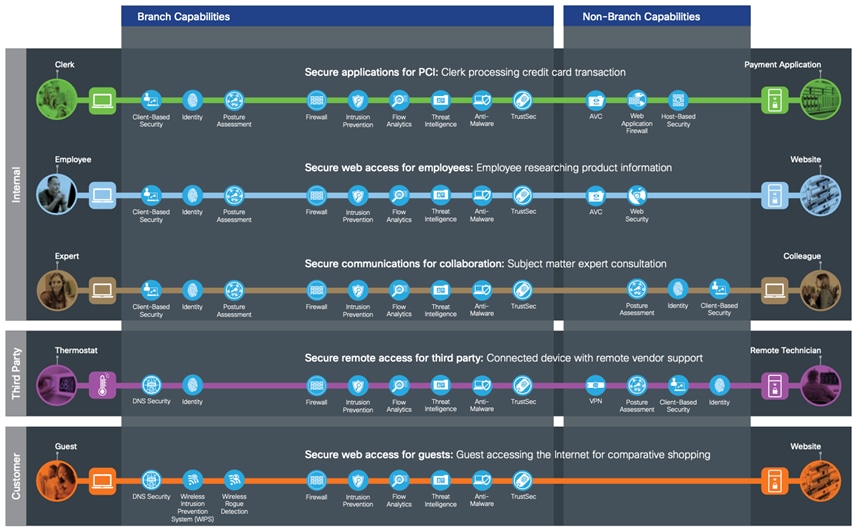
SAFE simplifies network security by providing solution guidance using the Places in the Network (PINs).
● Branch
● Campus
● Cloud
● Data Center
● Edge
● WAN
PINs are locations that are commonly found in networks and conceptually represent the infrastructure deployed in
these locations. They are blueprints for
the fundamentals that comprise today’s organizations: authentication, routing, switching, wireless, firewall, intrusion detection, and so on. Specific industry guidance for healthcare, retail, financial, and other verticals is covered in the Secure Domains.
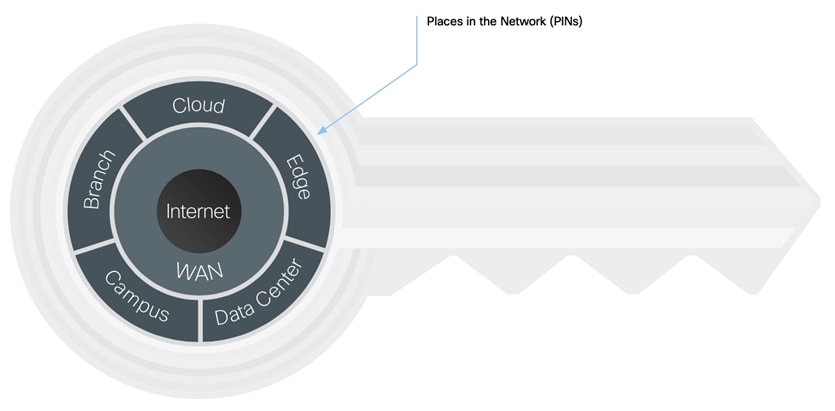
Branches are typically less secure than their campus and data center counterparts. Economics often dictate that it is cost prohibitive to duplicate all the security controls typically found at locations when scaling to hundreds of branches. However, this makes branch locations prime targets and more susceptible to a breach. In response, it is important to include vital security capabilities while ensuring cost-effective designs in the branch.
Top Threats Mitigated in the Branch:
● Endpoint malware (POS malware)
● Wireless infrastructure exploits (rogue AP, Man in the Middle)
● Unauthorized/malicious client activity
● Exploitation of trust
For more information, refer to the SAFE Secure Branch Architecture Guide.
The following figure shows the progression of security capabilities used to help defend against the attacks common in a branch.
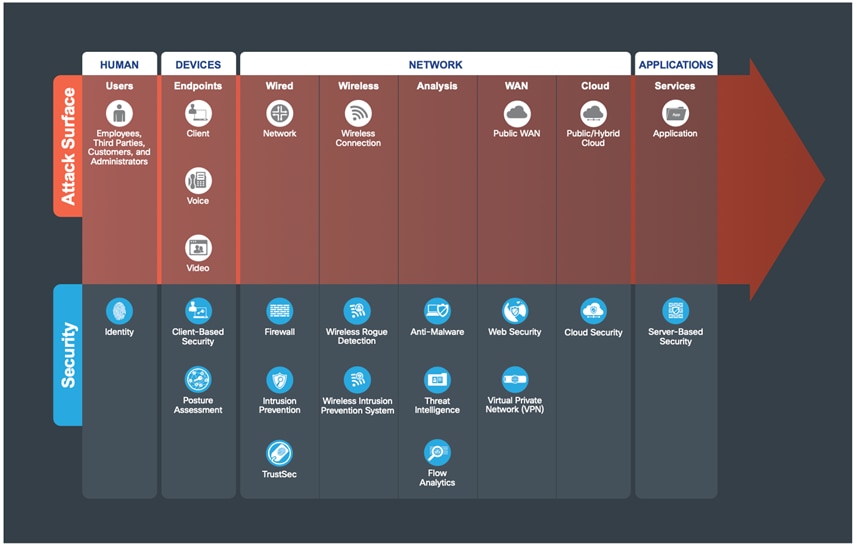
Campuses contain large user populations with a variety of device types and traditionally few internal security controls. Due to the large number of security zones (subnets and VLANs), secure segmentation is difficult. Because of the lack of security control, visibility, and guest/partner access, campuses are prime targets for attack.
Top Threats Mitigated in the Campus:
● Phishing
● Web-based exploits
● Unauthorized network access
● Malware propagation
● BYOD—Larger attack surface/
● increased risk of data loss
● Botnet infestation
For more information, refer to the SAFE Secure Campus Architecture Guide.
The following figure shows the progression of security capabilities that are used to help defend against the attacks common in a campus.
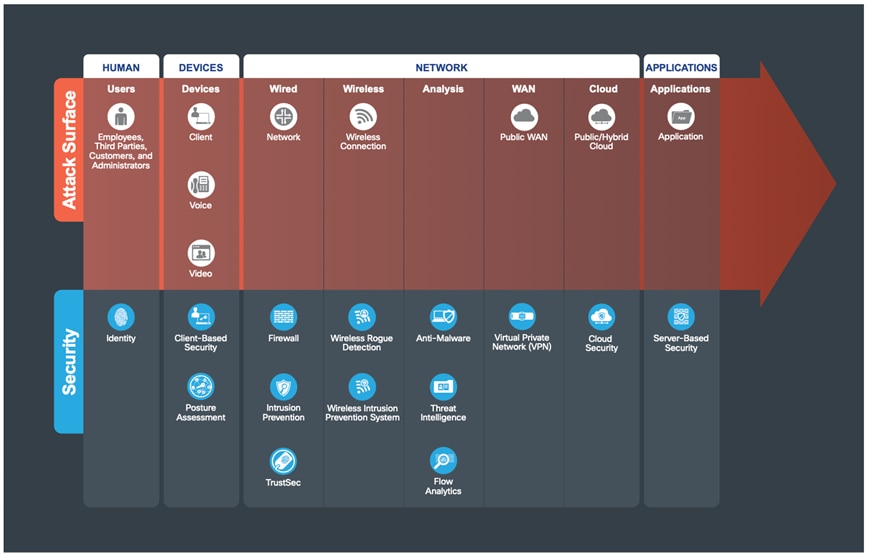
The majority of cloud security risk stems from loss of control, lack of trust, shared access, and shadow IT. Service Level Agreements (SLAs) are the primary tool for businesses to dictate control of security capabilities selected in cloud-powered services. Independent certification and risk assessment audits should be used to improve trust.
Top Threats Mitigated in the Cloud:
● Webserver vulnerabilities
● Loss of access
● Virus and malware
● Man-in-the-Middle (MitM)
For more information, refer to the SAFE Secure Cloud Architecture Guide.
The following figure shows the progression of security capabilities used to help defend against the attacks common in the cloud.
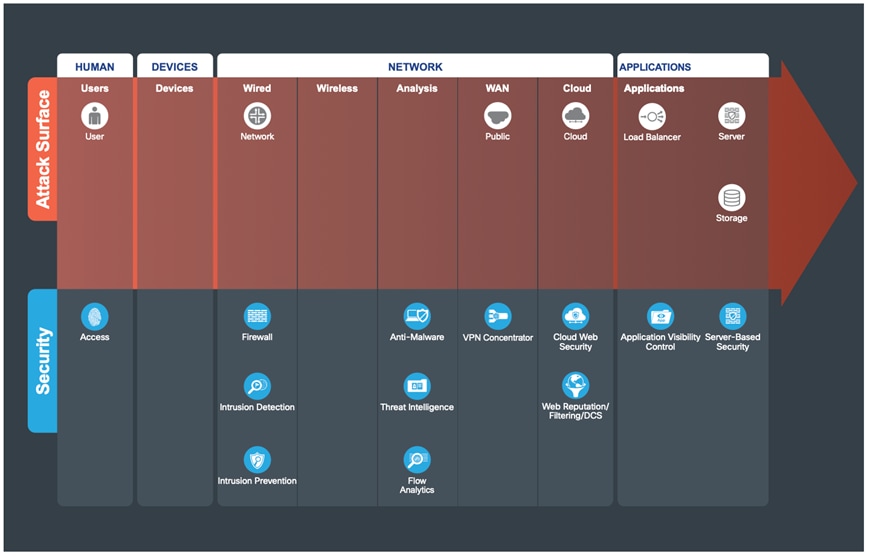
Data centers contain the majority of information assets and intellectual property. These are the primary goals of all targeted attacks and thus require the highest level
of effort to secure. Data centers contain hundreds to thousands of physical and virtual servers that are segmented by application type, data classification zone, and other methods. Creating and managing proper security rules to control access to (north/ south) and between (east/west) resources can be exceptionally difficult.
Top Threats Mitigated in the Data Center:
● Data extraction (data loss)
● Malware propagation
● Unauthorized network access (application compromise)
● Botnet infestation (scrumping) data loss, privilege escalation, reconnaissance)
For more information, refer to the SAFE Secure Data Center Architecture Guide.
The following figure shows the progression of security capabilities that are used to help defend against the attacks common in a data center.
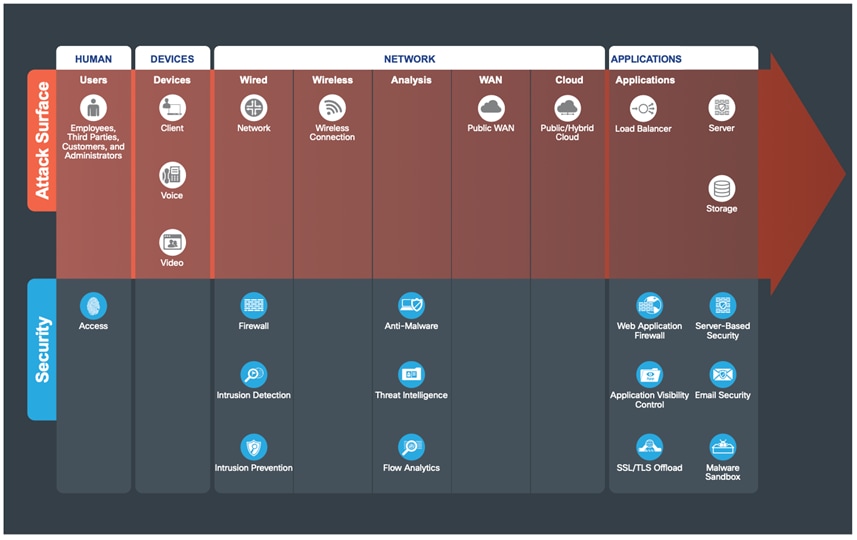
The edge is the highest-risk PIN because it is the primary ingress point for public traffic from the Internet and the primary egress point for corporate traffic to the Internet. Simultaneously, it is the most critical business resource in today’s Internet-based economy.
Top Threats Mitigated in the Edge:
● Webserver vulnerabilities
● Distributed denial of service (DDoS)
● Data loss
● Man-in-the-Middle (MitM)
For more information, refer to the SAFE Secure Edge Architecture Guide.
The following figure shows the progression of security capabilities that are used to help defend against the attacks common at the network edge.
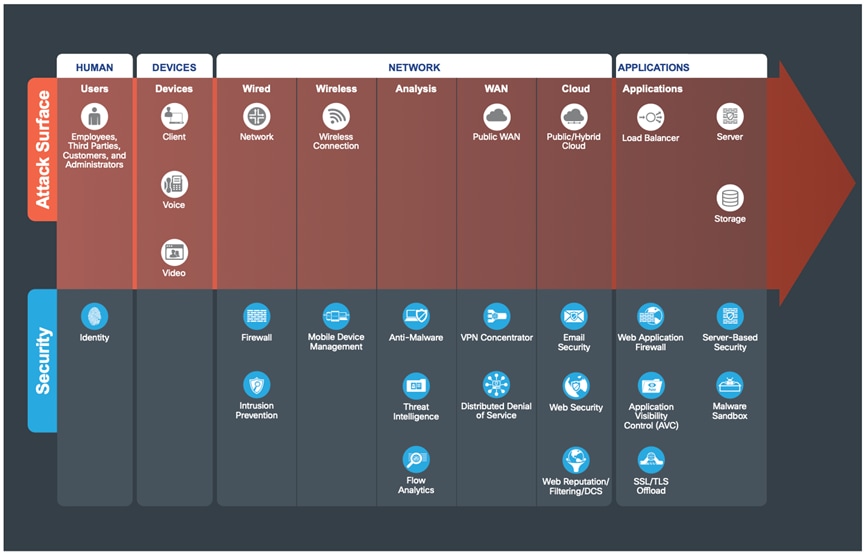
The WAN connects all company locations together to provide a single point of control and access to all resources. Managing security and quality of service (QoS) policies to control communication can be exceptionally difficult and complex.
Top Threats Mitigated in the WAN:
● Malware propagation
● Unauthorized network access
● WAN sniffing and MitM attacks
The following figure shows the progression of security capabilities used to help defend against the attacks common in a WAN.
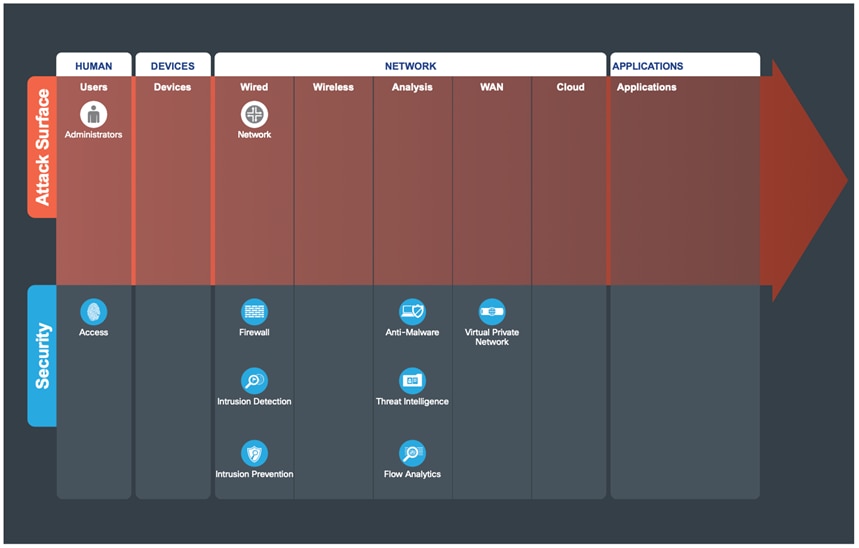
The Secure Domains represent the operational side of the Key. Operational security is divided by function and the people in the organization that are responsible for them. Each domain has a class of security capabilities and operational aspects that must be considered.
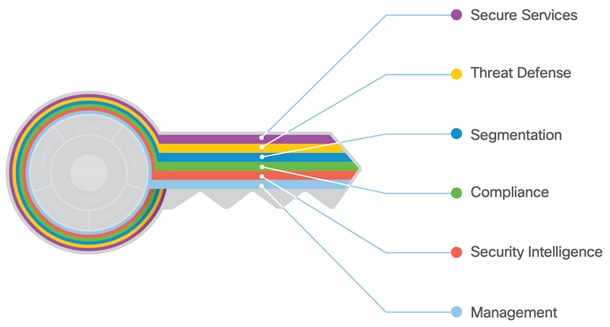
Management of devices and systems using centralized services is critical for consistent policy deployment, workflow change management, and the ability to keep systems patched. Management coordinates policies, objects, and alerting.
The following figure shows the progression of security capabilities used for the operations of Management.
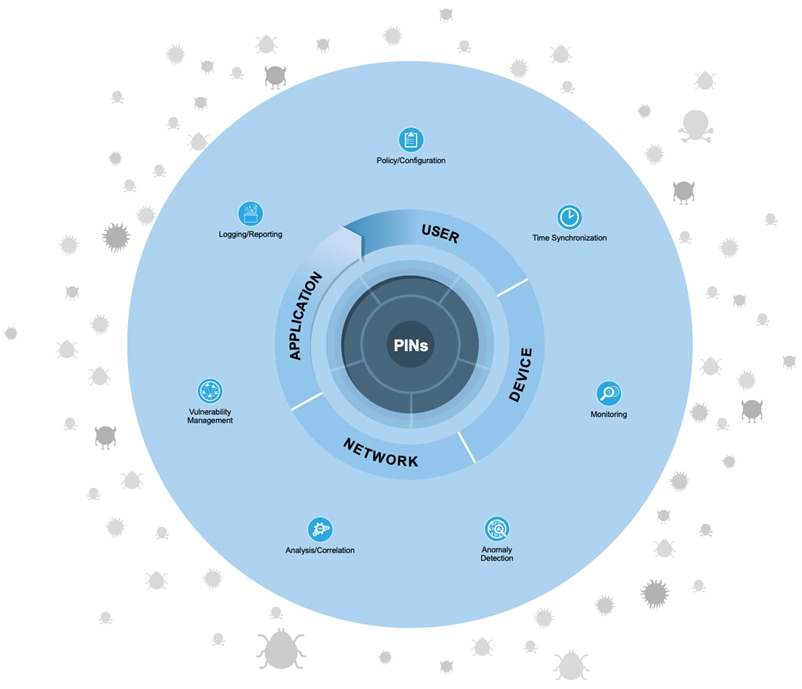
Security Intelligence provides global detection and aggregation of emerging malware and threats. It enables an infrastructure to enforce policy dynamically, as reputations are augmented by the context of new threats, providing accurate and timely security protection.
The following figure shows the progression of security capabilities used for the operations of Security Intelligence.
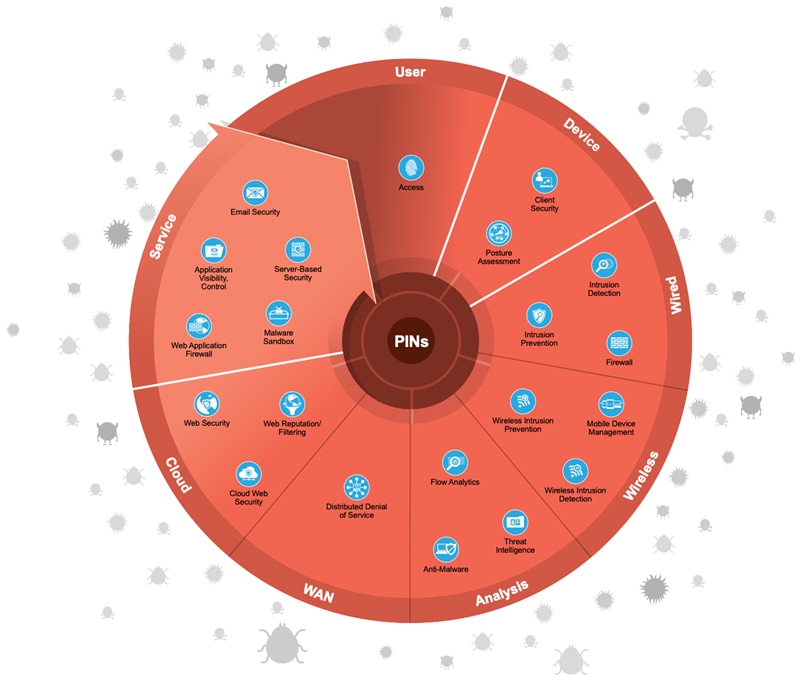
Compliance addresses internal and external policies. It shows how multiple controls can be satisfied by a single solution. Examples of external compliance include PCI, HIPAA, and Sarbanes-Oxley (SOX).
The following figure shows the progression of security capabilities used for Compliance.
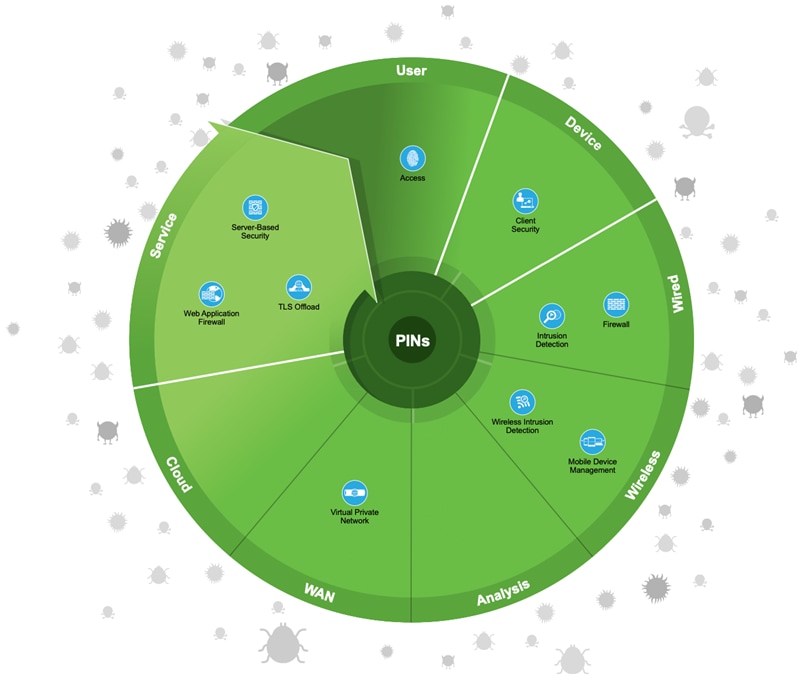
Segmentation establishes boundaries for data and users. Traditional manual segmentation uses a combination of network addressing, VLANs, and firewalls for policy enforcement. Advanced segmentation leverages identity-aware infrastructure to enforce automated and scalable policies.
The following figure shows the progression of security capabilities used for Segmentation.
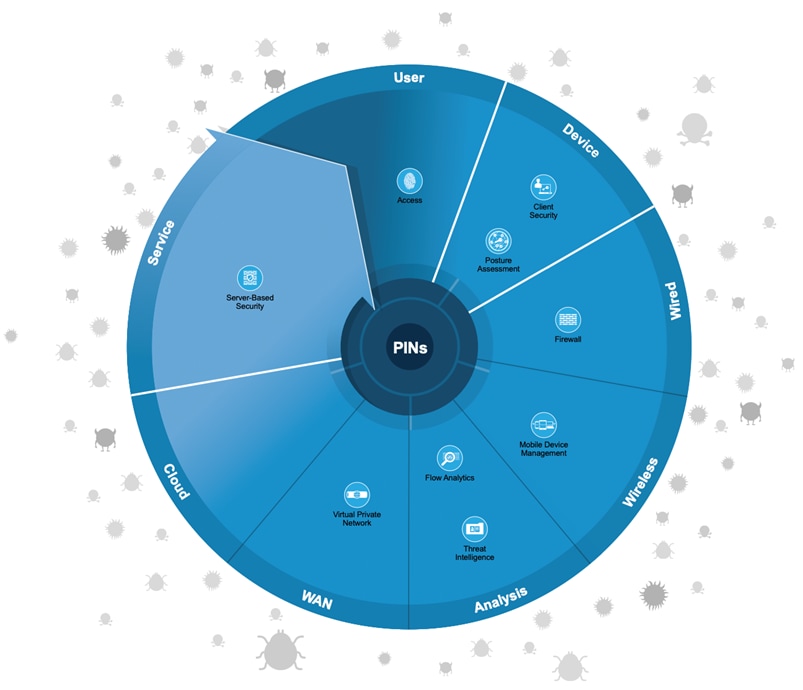
Threat Defense provides visibility into the most evasive and dangerous cyber threats. Using network traffic telemetry, reputation, and contextual information, it enables assessment of the nature and potential risk of the suspicious activity so you can take corrective action.
The following figure shows the progression of security capabilities used for the operations of Threat Defense.
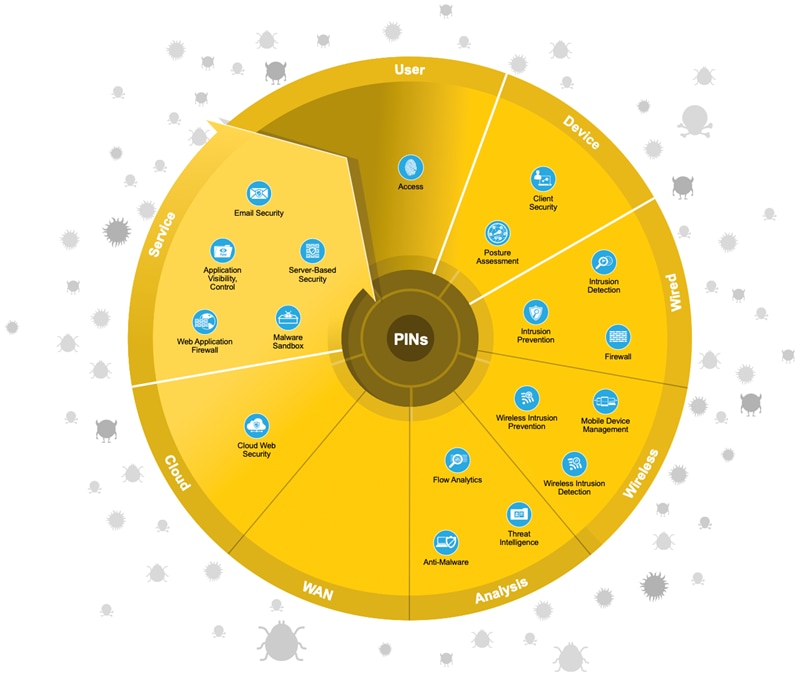
Secure Services provide technologies such as access control, virtual private networks, and encryption. This domain includes protection for insecure services such as applications, collaboration, and wireless.
The following figure shows the progression of security capabilities used for Secure Services.
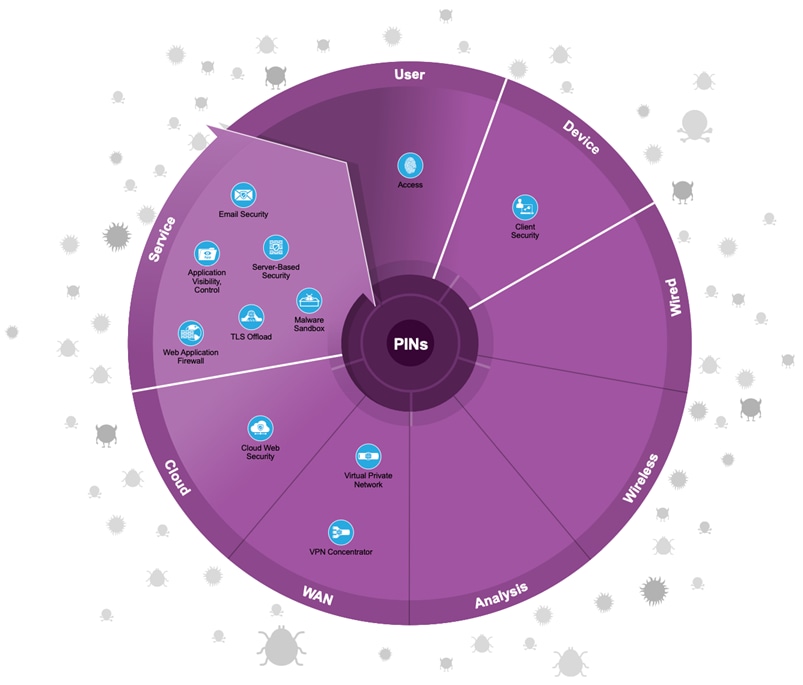
Capabilities describe the primary functions of a security service. The following table provides a definition for the capabilities used in SAFE. The recommended products are mapped to each capability, where and when it is used, and the top threats mitigated.
| Attack Surface |
Attack Surface Examples |
Security Capability Icon |
Secuity Capability Description |
Places in the Network |
Suggested Cisco Components |
| Human |
Users: Employees, contractors, customers, and administrators. |
|
Identity/ Authorization: Restriction of user access to services and resources. |
Secure Branch Secure Campus Secure Cloud Secure Data Center Secure Edge Secure WAN |
Identity Services Engine (ISE) Duo Meraki Mobile Device Management |
| Devices |
Clients: Devices such as PCs, laptops, smartphones, tablets. |
|
Client-Based Security: Security software to protect clients. |
Secure Branch Secure Campus Secure External Zones |
Secure Endpoint Secure Client Secure Access Umbrella |
|
|
Anti-Malware |
||||
|
|
Anti-Virus |
||||
|
|
Cloud Security |
||||
|
|
Personal Firewall |
||||
|
|
Posture Assessment: Client endpoint compliance verification and authorization. |
Secure Branch Secure Campus Secure External Zones |
Secure Client Duo Identity Services Engine |
||
| Network |
Wired Network: Physical network infrastructure; routers, switches, used to connect access, distribution, core, and services layers together. |
|
Firewall Segmentation: Stateful filtering and protocol inspection. |
Secure Branch Secure Campus Secure Data Center Secure External Zones Secure WAN |
Secure Firewall Meraki MX |
| Secure Cloud |
Multicloud Defense Secure Firewall
|
||||
|
|
Intrusion Prevention System: Identification of attacks by signatures and anomaly analysis. |
Secure Campus Secure Cloud Secure Data Center Secure Edge Secure External Zones Secure WAN |
Secure Firewall
|
||
|
|
Tagging: Contextual Segmentation |
Secure Branch Secure Campus Secure Data Center Secure Edge |
Nexus/Catalyst/Meraki Switch VLANs Identity Services Engine, pxGrid, TrustSec Application Centric Infrastructure (ACI) Endpoint Group (EPG) |
||
| Wireless Network: Branches vary from having robust local wireless controller security services to a central, cost- efficient model |
|
Mobile Device Management (MDM): Endpoint access control based on policies. |
Secure Edge
|
Meraki Mobile Device Management Identity Services Engine |
|
|
|
Wireless Rogue Detection: Detection and containment of malicious wireless devices that are not controlled by the company. |
Secure Branch Secure Campus |
Meraki Wireless Wireless LAN Controller |
||
|
|
Wireless Intrusion Prevention (WIPS): Blocking of wireless attacks by signatures and anomaly analysis. |
||||
| Analysis: Analysis of network traffic within the campus. |
|
Anti-Malware: Identify, block, and analyze malicious files and transmissions.
|
Secure Branch Secure Campus Secure Cloud Secure Data Center Secure Edge Secure WAN Secure External Zones |
Secure Endpoint |
|
|
|
Threat Intelligence: Contextual knowledge of emerging hazards. |
Secure Branch Secue Campus Secure Cloud Secure Data Center Secure Edge Secure WAN
|
Talos Threat Intelligence |
||
|
|
Flow Analytics: Network traffic metadata identifying security incidents. |
Secure Branch Secure Campus Secure Cloud Secure Data Center Secure Edge Secure WAN |
Secure Network Analytics Secure Cloud Analytics XDR |
||
| WAN: Public and untrusted Wide Area Networks that connect to the company, such as the Internet. |
|
VPN Concentrator: Encrypted remote access. |
Secure Edge |
Secure Firewall Meraki MX |
|
|
|
Virtual Private Encrypted communication tunnels. |
Secure Branch Secure Campus Secure Cloud Secure Data Center Secure WAN External Zones |
Secure Firewall Meraki MX
|
||
|
|
DDoS Protection: Protection against scaled attack forms. |
Secure Edge |
Secure DDoS |
||
| Cloud:
|
|
Cloud Security: Secure Internet Gateway or Secure Access Service Edge (SASE) |
Secure Branch Secure Campus Secure Cloud Secure Data Center Secure Edge Secure External Zones Secure WAN |
Secure Access Umbrella |
|
|
|
DNS Security: Enforces security at the DNS layer to block malware, phishing, and command and control callbacks over any port. |
||||
|
|
Firewall: Macro segmentation is the process of separating a network topology into smaller sub-networks, often known as zones. A firewall is typically the enforcement point between zones in a network. |
||||
|
|
Intrusion Prevention: An intrusion prevention system (IPS) provides network visibility, security intelligence, automation, and advanced threat protection. |
||||
|
|
Web Security: A full proxy that can log and inspect all your web traffic for greater transparency, control, and protection. IPsec tunnels, PAC files and proxy chaining can be used to forward traffic for full visibility, URL and application-level controls, and advanced threat protection. |
||||
|
|
Web Reputation Filtering: Compares each new website visited against known sites and then blocks access to sites that launch malicious code. |
||||
|
|
TLS/SSL Decryption: Ability to decrypt and inspect encrypted web traffic and block hidden attacks. |
||||
|
|
Remote Browser Isolation: Provides an added layer of protection against browser-based security threats for high-risk users. RBI moves the most dangerous part of browsing the internet away from the end user’s machine and into the cloud. |
||||
|
|
Network Anti-Malware: Advanced malware’s goal, in general, is to penetrate a system and avoid detection. Once loaded onto a computer system, advanced malware can self-replicate and insert itself into other programs or files, infecting them in the process. Anti-malware protection should be implemented in both the network (to prevent initial infection and detect attempts of spread) and in the endpoint (to prevent endpoint infection and remove unwanted threats). This capability represents network anti-malware. |
||||
|
|
Malware Sandbox: Inspects and Analyzes suspicious files.
|
||||
|
|
Cloud Access Security Broker (CASB): An intermediary between cloud providers, cloud-based applications, and cloud consumers to enforce an organization’s security policies and usage. |
||||
|
|
Data Loss Prevention: Designed to stop sensitive information from leaving an organization. The goal is to stop information such as intellectual property, financial data, and employee or customer details from being sent, either accidentally or intentionally, outside the corporate network. |
||||
|
|
Application Visibility & Control: Visibility and access control to approved web applications. |
||||
| Applications |
Application |
|
Application Dependency Mapping: Creates a map of all the components of an application. Enables network admins to build tight network security policies based on various signals such as network flows, processes, and other side information like load balancer configs. |
Secure Cloud Secure Data Center |
Secure Workload |
|
|
Process Anomaly Detection & Forensics: Anomaly detection is provided by performing hash analysis of all httpd binaries on the system, and reporting any mismatches. For all processes across the workloads if the rootscope, executable binary path, OS version or package info does not match the expected value, it is reported. Forensics enables monitoring and alerting for possible security incidents by capturing real-time forensic events and applying user-defined rules. |
Secure Cloud Secure Data Center |
Secure Workload |
||
|
|
Continuous Vulnerability Scanning: Continuously acquire, assess, and take action on new information in order to identify vulnerabilities, remediate, and minimize the window of opportunities for attackers. |
Secure Cloud Secure Data Center |
Secure Workload |
||
|
|
Tagging/Grouping for Software Defined Policy: Segmentation using Endpoint Groups (EPG), TrustSec Security Group Tag (SGT), or VLANs. |
Secure Cloud Secure Data Center |
Secure Workload Secure Firewall |
||
|
|
Policy Generation, Audit and Change Management: The output of application dependency mapping provide an allowed access list policy. This policy will need to be audited and changed as required. |
Secure Cloud Secure Data Center |
Secure Workload |
||
|
|
|
Micro-Segmentation: Micro-segmentation secure applications by expressly allowing particular application traffic and, by default, denying all other traffic. Granular east-west policy control provides a scalable way to create a secure perimeter zone around each workload with consistency across different workload types and environments. |
Secure Cloud Secure Data Center |
Secure Workload |
|
|
|
|
Runtime Application Self-Protection (RASP): A security technology that is built or linked into an application or application runtime environment, and is capable of controlling application execution and detecting and preventing real-time attacks. |
Secure Cloud Secure Data Center |
Panoptica |
|
|
|
|
Anti-Virus: Anti-Virus typically deals with older established threats such as trojans, viruses and worms. Anti-Virus is generally included in Anti-Malware solutions which also can detect new modern day threats. Anti-Malware solutions typically also include Anti-Virus capabilities. |
Secure Cloud Secure Data Center |
Secure Endpoint |
|
|
|
|
Anti-Malware: Advanced malware’s goal, in general, is to penetrate a system and avoid detection. Once loaded onto a computer system, advanced malware can self-replicate and insert itself into other programs or files, infecting them in the process. Anti-malware protection should be implemented in both the network (to prevent initial infection and detect attempts of spread) and in the endpoint (to prevent endpoint infection and remove unwanted threats). This capability represents endpoint anti-malware. |
Secure Cloud Secure Data Center |
Secure Endpoint |
|
| Storage: Information storage on all media types. |
|
Disk Encryption |
Secure Cloud Secure Data Center |
Cloud Storage Provider Data Center Provider |
|
| Server-Based Security: Security software to protect hosts. |
|
|
Secure Cloud Secure Data Center Secure Edge |
|
|
|
|
Anti-Malware |
Cisco Secure Endpoint |
|||
|
|
Anti-Virus |
Cisco Secure Endpoint |
|||
|
|
Cloud Security |
Cisco Umbrella |
|||
|
|
Host-based Firewall |
Cisco Secure Workload |
|||
|
|
Email Security: Messaging integrity and protections. |
Secure Data Center Secure Cloud Secure Edge |
Cisco Secure Endpoint Cisco Duo |
||
|
|
Malware Sandbox: Detonation and analysis of file behavior. |
Secure Data Center Secure Internet |
Secure Malware Analytics |
||
| Management |
Managment |
|
Logging/Reporting: Centralized event information collection. |
All |
Secure Cloud Analytics Secure Network Analytics |
|
|
Policy/Configuration: Unified infrastructure management and compliance verification. |
Firewall Management Center Cisco Defense Orchestrator |
|||
|
|
Time Synchronization: Device clock calibration. |
All systems and devices |
|||
|
|
Vulnerability Management: Continuous scanning and reporting of infrastructure. |
Vulnerability Management (Kenna) Firewall Management Center Cisco Defense Orchestrator |
|||
|
|
Analysis/ Correlation: Security event management of real-time information. |
Secure Cloud Analytics Secure Network Analytics XDR Firewall Management Center |
|||
|
|
Anomaly Detection: Identification of infected hosts scanning for other vulnerable hosts. |
Secure Cloud Analytics Secure Endpoint Secure Network Analytics XDR Firewall Management Center Cisco Defense Orchestrator |
|||
|
|
Monitoring: Network traffic inspection. |
Secure Cloud Analytics Secure Network Analytics XDR |
Table 9. SAFE Capabilities
The SAFE security reference architecture logically maps business flows to security capabilities from the source to the destination using Places in the Network (PINs). Each PIN has architectural layers that define where and why security controls are used.
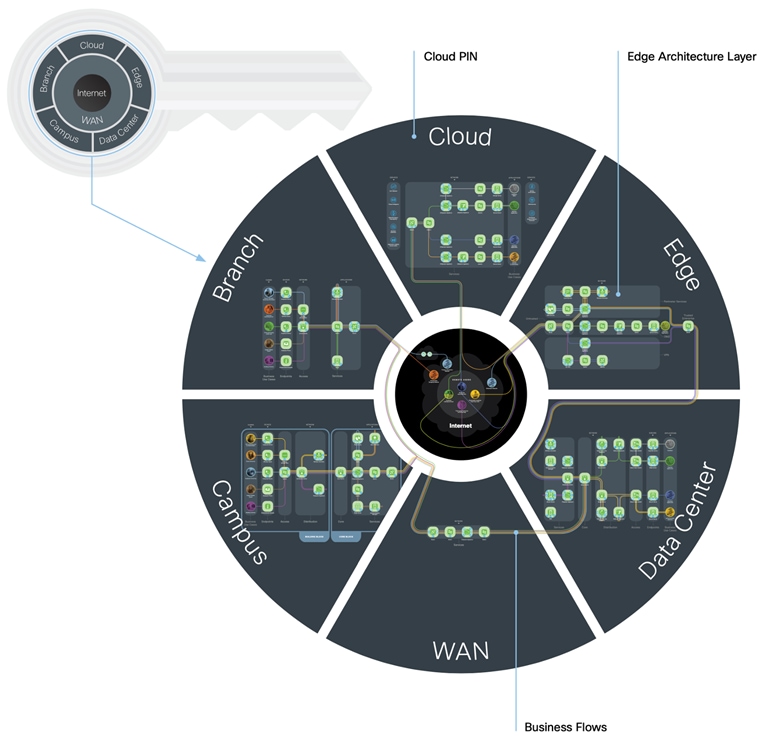
The Attack Surface and Architecture Layers
The SAFE architecture uses layers that align to the attack surface. Business use cases connect through the network to application services. Each layer has standardized controls relating to its function. Some layers provide access and visibility while others perform enforcement. Not all PINs contain all layers (see further definition in the architecture guide for each Place in the Network).
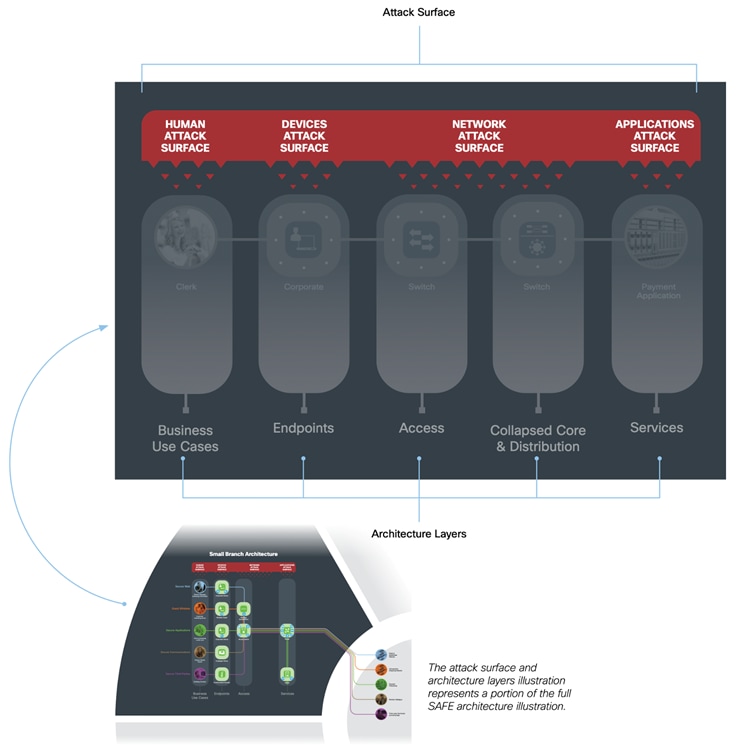
A Business Use Case is a role performed by a Human connecting to network services.
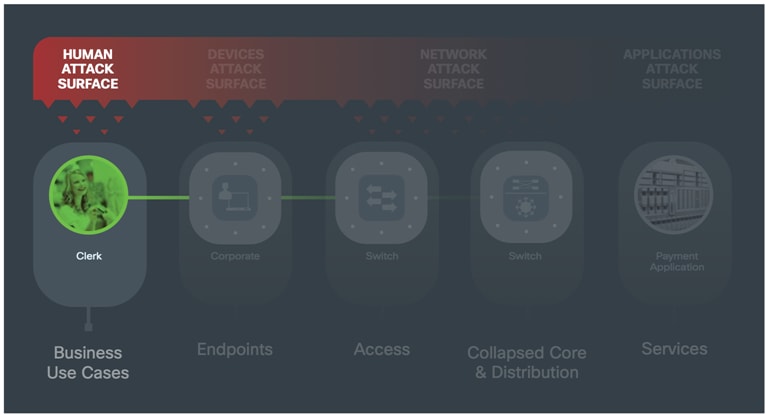
Humans use network services to perform business functions. Each business use case defines what services are needed and where the flow of data will go. Some users will perform multiple roles requiring respective security.
Humans can be the weakest link in your security architecture. If their identity is compromised, downstream technical controls can be bypassed. Visibility and segmentation limit the impact of compromised employees, malicious partners, or customers.
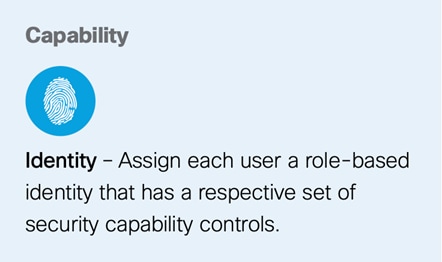
The Devices layer includes devices that vary from traditional PCs and laptops to smart phones, tablets, and increasingly, things such as building controls, cameras, and robotics. Devices require respective client-based security defined by policy.
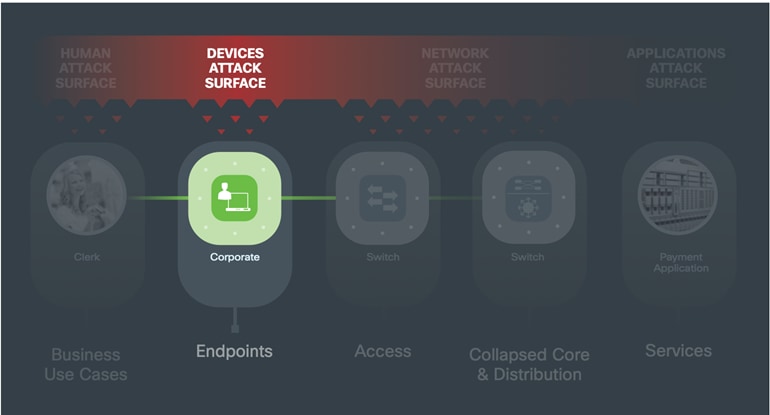
Zero day and other advanced attacks can bypass existing security. A secure company uses the network and the devices connecting to it as baselines of behavior. Under attack, new behavior compared to baselines provides alarm.
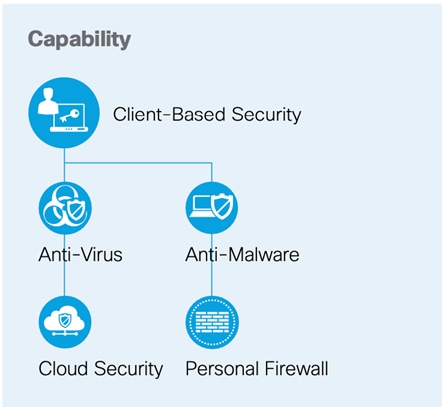
The SAFE model aligns to the traditional network model of access, distribution, and core. Each layer in the hierarchy benefits by dividing a flat network into scalable blocks. Traffic remains local unless it is destined for other networks, and it is elevated to a higher layer. The network acts as a sensor utilizing flow analytics to capture anomalies and provide visibility to attacks.
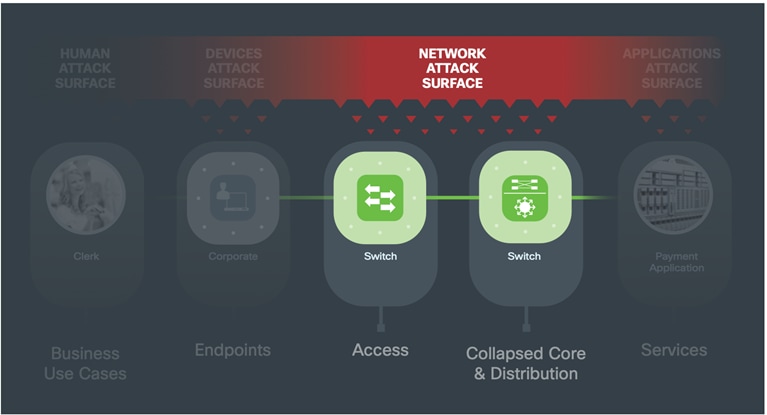
The purpose of the access layer is to securely connect humans and devices to the network. It connects to the distribution layer and is the first line of enforcement to the rest of the network. Its purpose is to identify and segment users, and to assess compliance of devices seeking access. This layer enables enforcement of violations of posture, identity, or anomalous behavior.
This layer is an aggregation point for all of
the access switches. It controls the boundary between the access and core layers and serves as an integration point for security capabilities such as IPS and network policy enforcement.
The core layer provides high-speed, highly redundant forwarding services, connecting the distribution layer to the services layer. In smaller locations not requiring scale, distribution or access layers connect directly to the core.
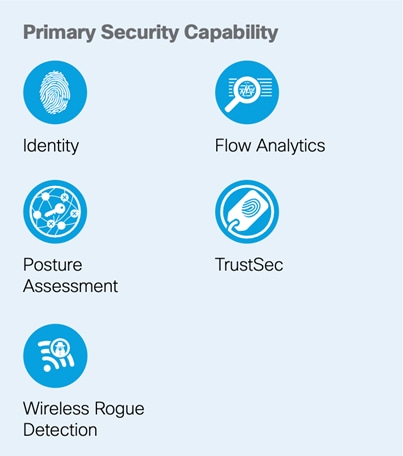
The purpose of the services layer is to provide and secure services used by business functions.
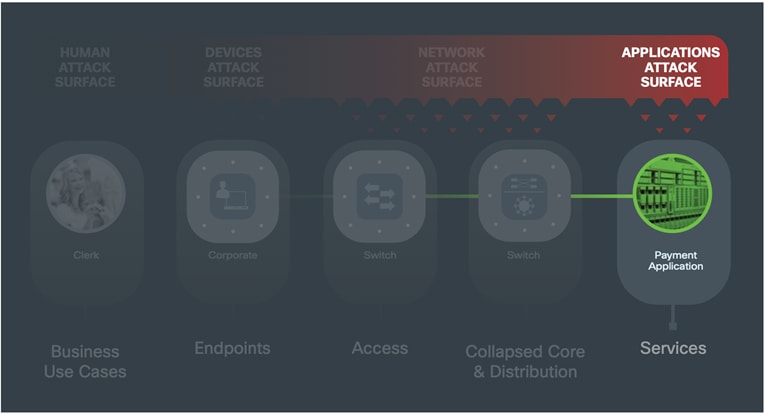
The services layer typically connects to the core layer and provides foundational capabilities. The security capabilities segment traffic and provide visibility into separated business flows. Through analytics, each Place in the Network has protection from known malware and other malicious intrusions. In the event of zero-day attacks where the threat has not been categorized, flow analytics identifies anomalous behavior, reducing time to detection. Policy is enforced against violations.
Business-based security protects against threats introduced outside the company, such as email correspondence, web surfing, and remote access. Many businesses need to satisfy compliance mandates using rogue wireless detection regardless of whether the company uses wireless itself. If a company uses wireless for business functions, WIPS is needed in addition to foundational IPS.
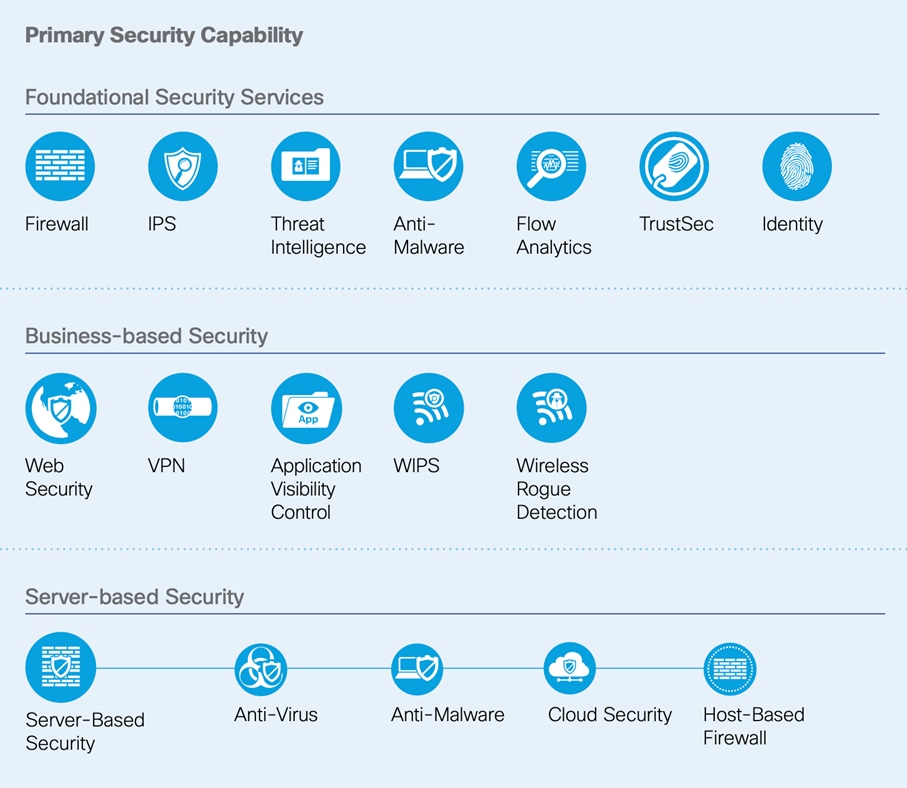
Companies are threatened by increasingly sophisticated attacks. SAFE provides a model and a method for simplifying the complexity associated with defense. By segmenting company business into role-based business flows, appropriate security capabilities are applied. Organizing these capabilities into architectures, SAFE standardizes how the business is secured. Finally, designs complete with materials, configurations, and cost are created based on these security business architectures.
SAFE simplifies the security challenges of today and prepares for the threats of tomorrow.
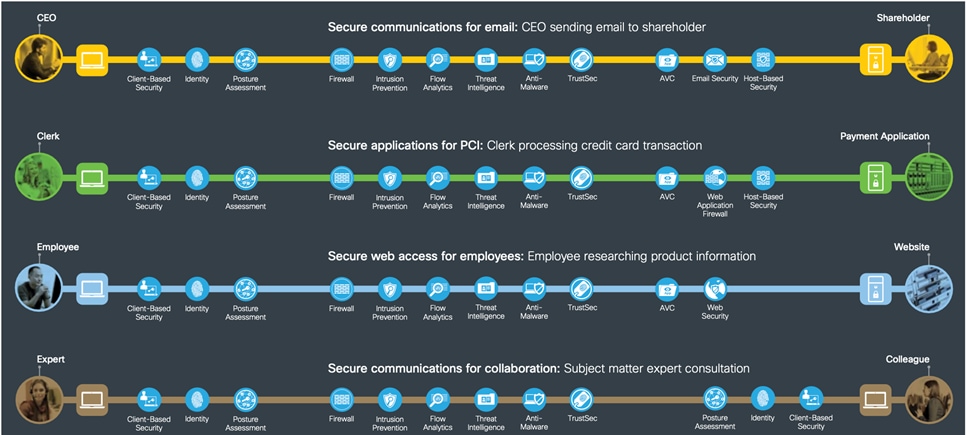
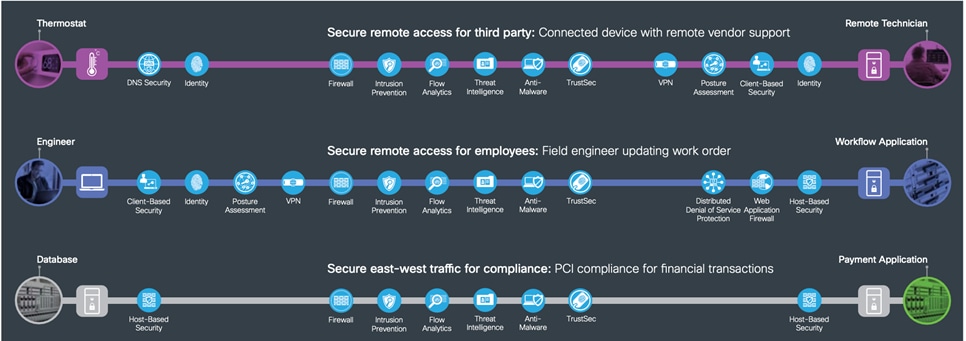
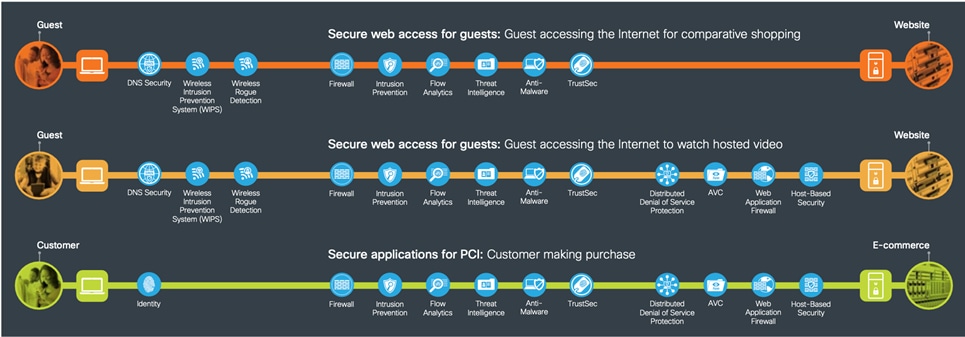
If you have feedback on this design guide or any of the Cisco Security design guides, please send an email to ask-security-cvd@cisco.com.
For more information on SAFE, see www.cisco.com/go/SAFE.





